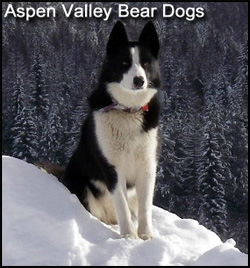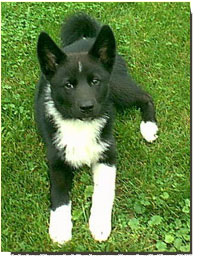
Karelian Bear Dog
Group: Working Group
Origin: Finland
Height:
– Males: 21 1/4 to 23 1/2 inches (54-60 cm); Ideal height is 57 cm.
– Females: 19 1/4 to 21 1/4 inches (49-54 cm); Ideal height is 52 cm.
Weight:
– Males: 25 – 28 kgs.
– Females: 17 – 20 kgs.

CLICK HERE to View Breeder Listings
Breed Profile
The Karelian Bear Dog is a medium-sized member of the Spitz family of dogs. He is an extremely resourceful, intelligent and courageous hunter, and a true working dog that requires outdoor exercise and is happiest with a hunter or outdoorsman. The breed is primarily a hunting dog but, in his native Finland, he is also seen participating in obedience trials, search and rescue as well as sled dog competitions.
His temperament is stable but reserved and he is very devoted to his master. Karelians trail their prey silently and usually work alone as they are known to be aggressive toward other dogs, especially in their own territory. The Karelian’s fearlessness and strong hunting instinct mean that he will attack a bear or other large game without hesitation.
The Karelian has a straight, stiff and thick outer coat and a soft, dense undercoat that provides insulation. He is black with distinct white markings on the head, neck, chest, abdomen and legs.
A Brief History of the Karelian Bear Dog
The Karelian Bear Dog (Karjalankarhukoira) is native to Karelia in Northern Europe which was once part of Finland. The Komi dog is considered to be the origin of the breed. For centuries, the breed with its keen sense of smell, has been used to hunt large game including moose, elk and bear.
The breed nearly died out in his native Finland until, in the 1930s, the Finnish Kennel Club undertook to restore the breed. The Finnish Kennel Club first registered the breed in 1946 and, today in Finland, he is one of the most highly regarded and among the top ten most common breeds. The Canadian Kennel Club recognized the breed in 1979 and the United Kennel Club first recognized the breed in 1996. The breed has not yet gained American Kennel Club recognition but is accepted for recording under the AKC Foundation Stock Service Program.
Health Issues
If you are considering the adoption of a Karelian Bear Dog puppy, or any breed, it is very important to be selective in choosing a responsible and reputable breeder. Ensure that the prospective puppy’s parents have all health clearances. Breeding of any dog should not be done until after they have been proven to be free of evidence of significant hereditary diseases. (For more information on selecting a breeder, see the articles on the main General Information page.)
Additional Health Resources:
- Health and Nutrition — Growing section of the Canada’s Guide to Dogs website which includes information on several health and nutrition related issues.
- Canine Health Information Center (CHIC) — Providing a source of health information for owners, breeders, and scientists that will assist in breeding healthy dogs. CHIC is a centralized canine health database jointly sponsored by the AKC/Canine Health Foundation (AKC/CHF) and the Orthopedic Foundation for Animals (OFA).
- AKC Canine Health Foundation — Working towards developing scientific advances in canine health.
- Companion Animal Eye Registry (CAER)
- Orthopedic Foundation for Animals (OFA)
- Ontario Veterinary College (OVC)
- University of Pennsylvania Hip Improvement Program (PennHip)
- HealthGene — HealthGene Corporation is the leading provider of veterinary DNA diagnostic services in Canada.
- Labgenvet — Laboratory of Veterinary Genetics is a Canadian diagnostic laboratory that offers a comprehensive service of DNA tests for veterinary genetic diseases.
Breed Standards
- CKC Breed Standard
- UKC Breed Standard
- F.C.I. Standard No. 48 – (Karjalankarhukoira)
- The Karelian Bear Dog is accepted for recording in the AKC Foundation Stock Service and assigned the Working Group designation.

Photo: Kodiak
Courtesy of Running Bear Kennels – www.rbkennels.com
Grooming Information
- Grooming — This section of the Canada’s Guide to Dogs website includes tips, articles and information covering all aspects of dog grooming along with a listing of Groomers from across Canada.
Training Resources
- Training — For training information, see this growing section of the Canada’s Guide to Dogs website for tips, articles, as well as listings of training centres across Canada.
Additional Information
- Clubs, Sports & Activities — For information on the many sports and activities you can get involved in with your dog.
- Working Dogs — The Working Dogs section of the Canada’s Guide to Dogs website provides information and listings of organizations that are involved in various dog jobs, such as Guide Dogs, Therapy Dogs, Police Dogs, Protection Dogs, and much more.
*NOTE 1: CHIC – The Canine Health Information Center “is a database of consolidated health screening results from multiple sources. Co-sponsored by the Orthopedic Foundation for Animals (OFA) and the American Kennel Club (AKC) Canine Health Foundation, CHIC works with parent clubs to identify health screening protocols appropriate for individual breeds. Dogs tested in accordance with the parent club established requirements, that have their results registered and made available in the public domain are issued CHIC numbers.” To learn more, visit: www.caninehealthinfo.org
*NOTE 2: The Fédération Cynologique International (FCI) is the World Canine Organization, which includes 91 members and contract partners (one member per country) that each issue their own pedigrees and train their own judges. The FCI recognizes 344 breeds, with each being the “property” of a specific country. The “owner” countries write the standards of these breeds in co-operation with the Standards and Scientific Commissions of the FCI, and the translation and updating are carried out by the FCI. The FCI is not a breed registry nor does it issue pedigrees.
Breed Listing
Quick Links
Get In Touch
- Email: canadasguidetodogs@gmail.com
- Email: info@canadasguidetodogs.com
- Visit us on Facebook: www.facebook.com/CanadasGuideToDogs
— CanadasGuideToDogs.com is an Amazon Associate as well as a participant in various affiliate programs, as such fees are earned from qualifying purchases.
